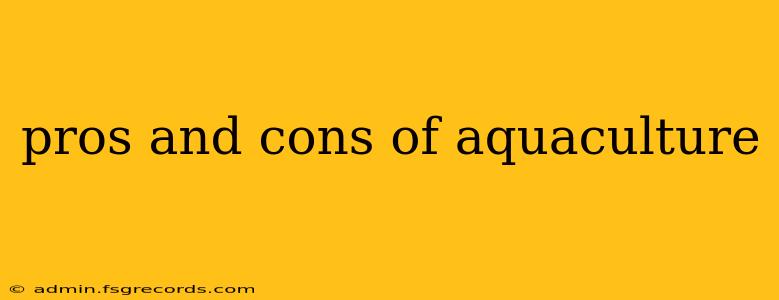Aquaculture, also known as fish farming, is rapidly expanding to meet the global demand for seafood. While it offers significant advantages in food production, it also presents considerable environmental and social challenges. Understanding both the pros and cons is crucial for developing sustainable aquaculture practices.
The Advantages of Aquaculture: Feeding a Growing Population
Aquaculture plays a vital role in supplying seafood to a world population projected to reach nearly 10 billion by 2050. Its benefits are numerous:
1. Increased Food Production and Food Security:
- High yields: Aquaculture boasts significantly higher yields per unit area compared to traditional fishing, contributing to a more efficient and reliable food source. This is particularly important in regions with limited arable land.
- Reduced pressure on wild fish stocks: By providing an alternative protein source, aquaculture can lessen the pressure on overexploited wild fish populations, contributing to marine ecosystem health. This is especially true for species commonly consumed, reducing the need for wild-caught alternatives.
- Enhanced food availability and affordability: Increased production often translates to lower prices, making seafood more accessible to a wider range of consumers, improving dietary diversity and nutrition.
2. Economic Benefits:
- Job creation: The aquaculture industry creates numerous jobs across various sectors, from farming and processing to distribution and marketing, boosting local economies. This includes opportunities in rural areas, which may lack other employment options.
- Revenue generation: Aquaculture can generate significant revenue for both small-scale farmers and large-scale corporations, contributing to national economies and trade. This can lead to investment in improved technology and infrastructure.
- Improved livelihoods: For many communities, especially in developing countries, aquaculture offers an opportunity to escape poverty and improve their overall standard of living. This is particularly true for small-scale farmers.
3. Technological Advancements:
- Recirculating Aquaculture Systems (RAS): Modern technologies like RAS minimize water usage and waste discharge, significantly reducing the environmental impact of aquaculture. These systems are becoming increasingly efficient and cost-effective.
- Improved breeding techniques: Selective breeding programs have led to faster-growing and disease-resistant fish strains, improving productivity and reducing reliance on antibiotics. This contributes to both economic efficiency and animal welfare.
- Sustainable feed development: Research into sustainable feed ingredients, such as insect meal and algae, is reducing reliance on wild-caught fishmeal, mitigating the environmental impact of feed production.
The Drawbacks of Aquaculture: Environmental and Social Concerns
Despite its advantages, aquaculture presents various challenges that demand careful consideration and responsible management:
1. Environmental Impacts:
- Habitat destruction: The expansion of aquaculture can lead to the destruction of coastal ecosystems, including mangroves and seagrass beds, which are crucial for biodiversity and carbon sequestration.
- Water pollution: Waste discharge from aquaculture facilities can pollute surrounding waters, causing eutrophication (excess nutrients), harming water quality, and affecting marine life. This includes the release of uneaten feed, feces, and antibiotics.
- Disease outbreaks: High densities of fish in aquaculture farms can increase the risk of disease outbreaks, potentially spreading to wild populations. This necessitates the responsible use of antibiotics and effective biosecurity measures.
- Escape of farmed fish: Farmed fish escaping into the wild can interbreed with wild populations, potentially weakening their genetic diversity and impacting the survival of the wild stock.
2. Social and Economic Issues:
- Social conflicts: The expansion of aquaculture can lead to conflicts over resource use and access between different stakeholders, including local communities, farmers, and government agencies. These conflicts may involve land rights and environmental concerns.
- Economic inequality: The benefits of aquaculture are not always evenly distributed, with some communities benefiting more than others. This can exacerbate existing inequalities.
- Labor exploitation: Poor working conditions and low wages are reported in some aquaculture operations, highlighting the need for ethical and responsible labor practices.
Conclusion: Towards Sustainable Aquaculture
Aquaculture is essential for meeting global seafood demands, but its sustainability depends on addressing the environmental and social challenges it poses. Implementing responsible practices, such as improved waste management, sustainable feed development, and careful site selection, is crucial for minimizing its negative impacts. Furthermore, fostering transparency and traceability within the industry, along with robust regulatory frameworks, is essential for ensuring that aquaculture benefits both people and the planet. The future of seafood security rests on the development of sustainable and equitable aquaculture practices.

